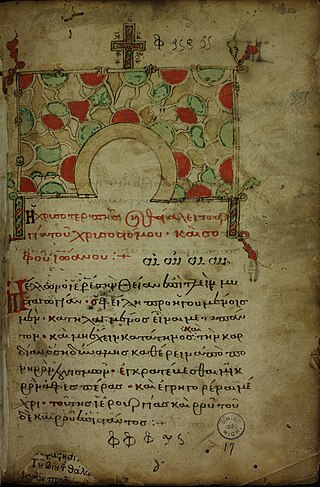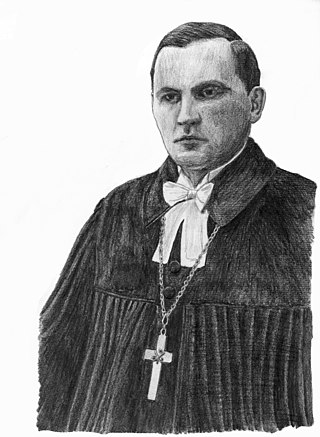The Lutheran School of Theology at Chicago (LSTC) is a seminary of the Evangelical Lutheran Church in America in Chicago, Illinois. LSTC is a member of the Association of Chicago Theological Schools (ACTS), a consortium of eleven area seminaries and theological schools. It shares the JKM Library and portions of its campus with McCormick Theological Seminary. LSTC is accredited by the Association of Theological Schools and regionally accredited by the Higher Learning Commission.

A biblical manuscript is any handwritten copy of a portion of the text of the Bible. Biblical manuscripts vary in size from tiny scrolls containing individual verses of the Jewish scriptures to huge polyglot codices containing both the Hebrew Bible (Tanakh) and the New Testament, as well as extracanonical works.
The Center for the Study of New Testament Manuscripts (CSNTM) is a 501(c)(3) non-profit organization whose mission is to digitally preserve Greek New Testament manuscripts. Toward that end, CSNTM takes digital photographs of manuscripts at institutions, libraries, museums, monasteries, universities, and archives around the world. The images produced are freely accessible on the Center's website—a searchable library of Greek New Testament manuscripts. With more than 50,000 users examining manuscripts in their digital library each year, the Center's digitization work facilitates a partnership between manuscript owners, archivists, and researchers around the world.

Minuscule 1424, δ 30 is a Greek minuscule manuscript of the New Testament, written on 337 parchment leaves. It has been dated paleographically to the 9th or 10th century).
Lectionary 214, designated by siglum ℓ214, is a Greek manuscript of the New Testament, on parchment. Palaeographically it has been assigned to the 12th century. Scrivener labelled it by 239evl.
Lectionary 215, designated by siglum ℓ215 is a Greek manuscript of the New Testament, on parchment. Palaeographically it has been assigned to the 13th or 14th century. Scrivener labelled it by 240evl.

Lectionary 216, designated by siglum ℓ216 is a Greek manuscript of the New Testament, on parchment. Palaeographically it has been assigned to the 13th century. Scrivener labelled it by 251evl and 64apost.
Lectionary 217, designated by siglum ℓ217 is a Greek manuscript of the New Testament, on parchment. Palaeographically it has been assigned to the 13th century. Scrivener labelled it by 241evl.
Lectionary 218, designated by siglum ℓ218 is a Greek manuscript of the New Testament, on paper. Palaeographically it has been assigned to the 15th century. Scrivener labelled it by 242evl.

Lectionary 220, designated by siglum ℓ220 is a Greek manuscript of the New Testament, on parchment. Palaeographically it has been assigned to the 13th century. Frederick Henry Ambrose Scrivener labelled it by 244evl. The manuscript is lacunose.

Lectionary 223, designated by siglum ℓ223 is a Greek manuscript of the New Testament, on paper. Palaeographically it has been assigned to the 15th century. Frederick Henry Ambrose Scrivener labelled it by 252evl. It contains much additional material, liturgical and secular.
Lectionary 224, designated by siglum ℓ224 is a Greek manuscript of the New Testament, scribed on parchment. Palaeographically it has been assigned to the 14th century. Frederick Henry Ambrose Scrivener labelled it by 247evl.
Lectionary 221, designated by siglum ℓ221 is a Greek manuscript of the New Testament, on paper. Palaeographically it has been assigned to the 15th century. Scrivener labelled it by 245evl. The manuscript has complex contents.
Lectionary 222, designated by siglum ℓ222 is a Greek manuscript of the New Testament, on parchment. Palaeographically it has been assigned to the 13th century. Scrivener labelled it by 246evl.

Lectionary 225, designated by siglum ℓ225 is a Greek manuscript of the New Testament, on paper. Palaeographically it has been assigned to the 15th century. Scrivener labelled it by 248evl. The manuscript has complex contents.

Lectionary 226, designated by siglum ℓ226 is a Greek manuscript of the New Testament, on parchment. Palaeographically it has been assigned to the 14th century. F. H. A. Scrivener labelled it by 249evl. Some leaves of the manuscript were lost, and some leaves have survived in a fragmentary condition.

Lectionary 227, designated by siglum ℓ227 is a Greek manuscript of the New Testament, on parchment. Palaeographically it has been assigned to the 14th century. Scrivener labelled it by 250evl. Many leaves of the manuscript were lost, although some have survived in a fragmentary condition.

Lectionary 228, designated by siglum ℓ228 is a Greek manuscript of the New Testament, on paper. Palaeographically it has been assigned to the 15th century. Frederick Henry Ambrose Scrivener labelled it by 253evl. Some leaves of the manuscript were lost.
Lectionary 304 (Gregory-Aland), designated by siglum ℓ304 is a Greek manuscript of the New Testament, on paper. Palaeographically it has been assigned to the 14th century. The manuscript is lacunose.

Arthur Võõbus was an Estonian theologian, orientalist, and church historian.









